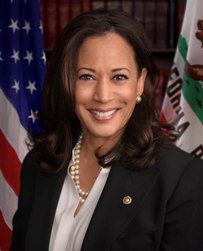In How Many States Will Harris Fail to Win 30 Percent of the Vote?
Democratic futility in statewide presidential elections has outpaced that by the GOP by more than four to one across the nation’s 50 states since 1964

Clinton failed to win 30 percent of the vote in six states – the most by any nominee by either party since President Jimmy Carter’s nine in 1980 (Alaska, Arizona, Idaho, Nebraska, Nevada, New Hampshire, North Dakota, Utah, Wyoming).
In each of those six states, Biden improved on the Democratic vote share by a larger margin than the 3.2 points he did nationally:
- Wyoming (+4.7 points): 21.9 percent for Clinton, 26.6 percent for Biden
- West Virginia (+3.5 points): 26.2 percent for Clinton, 29.7 percent for Biden
- Utah (+10.0 points): 27.2 percent for Clinton, 37.2 percent for Biden
- North Dakota (+4.6 points): 27.2 percent for Clinton, 31.8 percent for Biden
- Idaho (+5.5 points): 27.5 percent for Clinton, 33.0 percent for Biden
- Oklahoma (+3.4 points): 28.9 percent for Clinton, 32.3 percent for Biden
Will the number of states in which Harris does not reach the 30 percent mark increase or decrease this November?
The nation is close to evenly divided once again this cycle and the Donald Trump campaign appears to be making a strong effort to blunt any attempt by Harris to characterize herself as a moderate like Biden was able to do to some extent during his campaign four years ago. If Trump is successful in that endeavor, that should drive down Harris’ support in the nation’s deep red states vis-à-vis Biden 2020.
Over the last 100 years, no Democratic nominee has won the White House whilst simultaneously falling shy of 30 percent of the popular vote in more than three states.
Franklin Roosevelt did not dip below 30 percent in any of his four victories. [In fact, he received at least 40 percent of the vote in 191 of the 192 state contests – falling short only in Kansas in 1944 with 39.2 percent].
Likewise, the wins by John F. Kennedy in 1960, Carter in 1976, Bill Clinton in 1996, and Barack Obama in 2008 all saw the Democratic nominees receive at least 30 percent of the vote in every state.
In addition to Biden, four other Democrats were elected president even with a few ‘sub-30 states’ on their scorecards:
- Harry Truman, 1948 (three states): Alabama (not on ballot), Mississippi (10.1 percent), South Carolina (24.1)
- Lyndon Johnson, 1964 (two states): Alabama (not on ballot), Mississippi (12.9 percent)
- Bill Clinton, 1992 (three states): Idaho (28.4 percent), Nebraska (29.4 percent), Utah (24.7 percent)
- Barack Obama, 2012 (two states): Utah (24.5 percent), Wyoming (27.8 percent)
Due to the strong candidacy of Ross Perot, it should be noted that Clinton’s 1992 victory also had the largest number (49) and percentage (96.1 percent) of states won with a plurality in U.S. presidential election history – thus driving the numbers closer to the 30 percent mark for both major party winners and losers. With Robert F. Kennedy, Jr. suspending his campaign and off the ballot in most states, there is not likely to be a substantial third party or independent candidate having a similar effect in 2024.
Overall, Democratic nominees for president since 1964 have failed to reach the 30 percent mark 55 times out of 750 state elections (excluding D.C.), or 7.3 percent, across 20 states.
Republican nominees, meanwhile, have done so just 13 times, or 1.7 percent (and in only six states: Alabama, Hawaii, Louisiana, Massachusetts, Mississippi, and Rhode Island).
If Harris’ support does not reach 30 percent in more than a couple of states, some of the most likely candidates (in addition to West Virginia) will come from the following list of states in which Democratic presidential nominees have lost a state record 14 consecutive races: Alaska, Idaho, Kansas, Nebraska, North Dakota, Oklahoma, South Dakota, Utah, and Wyoming.
Follow Smart Politics on X/Twitter.

– Though often forgotten – or overlooked – now FDR did lose the 1920 election for vice president. Interestingly, the “shellacked” James Cox/FDR ticket managed to garner 32.5% of the KS vote, slightly lower than the 34.2% national vote share – and *higher* than in some states that are part of the Democratic electoral fortress today!
– “…close to evenly divided…” Paradoxically, most venues have become *less* closely divided, as indicated by the “sub-30%” votes for Biden and BHO (2012), even though their two-party vote shares were/are higher than those for Carter or Kennedy.
– With noted anti-vaxxer RFK, jr no longer a candidate in the election (though his name apparently will remain on ballot in a handful, such as MI and NC) VP Harris seems likely to attain =>30% of the statewide vote in nearly every venue (51 jurisdictions) – with likely exceptions in WV (a lost cause from 2004 onward, regardless of the background of the nominee), as well as ND and WY (dearth of urban cores; surfeit of fossil fuel energy sources).
– Only one jurisdiction – Washington, District of Columbia – voted <30% for the MAGA ticket in either '16 or '20, though Vermont, an overwhelmingly non-Hispanic White state, came close to not reaching that low baseline in both cycles.
– For this cycle, the 'Project 2025' – influenced presidential ticket seems poised to garner <30% in DC, VT, HI (the Aloha State has both a pro-Democratic and pro-incumbent preference; unlike 2020 this time both forces are *in synch*), and perhaps CA, which also happens to be a former home state of the current junior senator from OH.
– The quirky positions of the two major party nominees may lead many to wonder…..'Who's the Incumbent?'